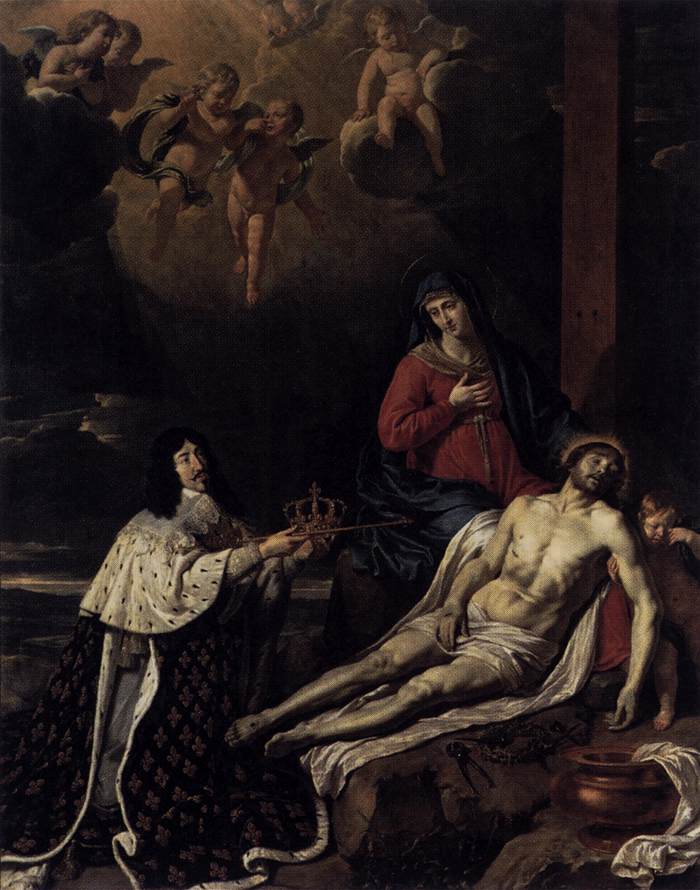The Cathedral, the Virgin, and the Kings:
The Vows of Louis XIII and Louis XIV
By Mitchell Laskowski and Marian Bleeke
The cathedral of Notre-Dame, the figure of the Virgin Mary, and the French monarchy were intertwined from the building’s beginnings. The dedication of the cathedral to “notre dame” or “our lady” is a dedication to the Virgin and she is a main character in the sculptures that surround the building’s western doorways. The sculptures on the west front also include a row of kings and one of the first people to buried in the building was a brother to King Louis VIII (although the brothers didn’t get along very well). However, the relationship between the building, the Virgin, and the kings went to whole new level in the 1600’s as Louis XIII and then Louis XIV made vows to the Virgin that made her the official patroness of France and redid the cathedral’s high altar in order to highlight this new relationship.
Louis XIII signed his vow to Mary on February 10, 1638. It’s official title is “Declaration of the King by which His Majesty declares that he has adopted the very holy and glorious Virgin Mary as the special protectress of his kingdom” and it states “We have declared and declare that, taking the most holy and glorious Virgin as the special protectress of our kingdom, we consecrate to her in a particular way our person, our State, our crown and our subjects, beseeching her to inspire us to behave in a holy manner and to so diligently defend this kingdom against the endeavours of all its enemies that, whether it suffers the plague of war or enjoys the sweetness of peace, we implore God from the depth of our heart, that it may never depart from the path of grace leading to the path of glory.” In August of that year, a painting by Philippe de Champaigne of Louis offering his crown and scepter to the Virgin and the dead Christ was placed inside of the cathedral.
 |
| Philippe de Champaigne, Vow of Louis XIII, 1638. Public domain, via Wikimedia Commons |
At the time of his vow, Louis XIII was struggling: France was at war with Spain and after twenty years of marriage he was still awaiting the birth of a son and heir. In September 1638, Louis XIV, known as Louis Dieudonné or the God-given, was born. He renewed his father’s vow in 1650 and started renovations to the choir in 1699, working with Louis-Antoine de Noailles, the Archbishop of Paris, and Jules Hardouin-Mansart, the First Architect to the King. Mansart had elaborate plans for an altar under a canopy supported on spiraling columns, but these were shelved, likely because the money was being spent instead supporting French interests in the war of Spanish Succession. Finally, Mansart’s brother-in-law Robert de Cotte took over and executed a simpler plan between 1708 and 1723.
 |
| Nicolas Coustou, Pieta, 1723. Prajnadhyana, CC BY-SA 3.0 <https://creativecommons.org/licenses/by-sa/3.0>, via Wikimedia Commons |
The final version of the altar included three large marble sculptures. In the center was a Pieta, an image of the Virgin holding the dead Christ in her lap, crafted by Nicolas Coustou. On the right of this statue was a sculpture of Louis XIII handing his crown and scepter to Mary, sculpted by Guillaume Coustou. And on the other side of the Pieta, a work done by Antoine Coysevox that showed Louis XIV with his hand on his heart assuring Mary of his faithfulness.
 |
| Guillaume Coustou, Vow of Louis XIII. aconcagua, CC BY-SA 3.0 <https://creativecommons.org/licenses/by-sa/3.0>, via Wikimedia Commons |
These sculptures were removed from the cathedral to a museum during the French Revolution and then returned to the building afterward. Since 1989, however, the altar they frame has not been the high altar for the cathedral, and in 1994 a large cross by the artist Marc Couturier was placed behind the Pieta and gave a new focus to the sculptural group. The Pieta sculpture featured prominently in photographs of the interior after the 2019 fire where it was used to suggest both despair, over the death of Jesus and the burning of the building, and hope, of his resurrection and the building’s restoration.
Sources:
Dany Sandron and Andrew Tallon, Notre Dame Cathedral: Nine Centuries of History. The Pennsylvania State University Press, 2020.
Comments
Post a Comment